| 1 | A quieter Australian killer |
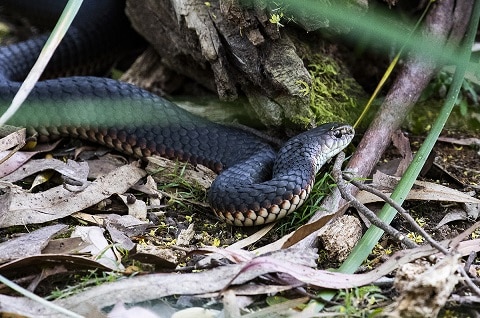
Australia has over a dozen venomous snakes, some of which have the good manners to warn you, by slithering around towns in a constantly agitated state and generally acting unhinged. This includes the demented eastern brown snake, which won’t allow anyone to come close without hissing madly. Then you have a far shier and more humble venomous snake: the lowland copperhead (Austrelaps superbus).
This is a species of cooler southern Australia. They’re one of the few snakes to inhabit Tasmania, while on the mainland, they inhabit Victoria and a tiny portion of South Australia (no New South Wales). Lowland copperheads are common in open grassy areas, as well as sparse woodlands, and wetland areas dotted with ponds and marshes. They have an amazing ability to cope with manmade interference, and can dwell in agricultural land 100 years after it was first transformed.
Ditches on the edges of crop fields are a prime place to find lowland copperheads. While relatively flexible, this species never appears in dense forests, and rarely urban areas.
Lowland copperheads reach a maximum of 183cm, but are more commonly 90-110cm. Males are longer than females. Lowland copperheads have no relation to the US copperhead, and are part of the 3-member Austrelaps genus, all found in southern Australia. The other members of this clan are the highland copperhead and pygmy copperhead.
| 2 | Rarely bites, but can be fatal |
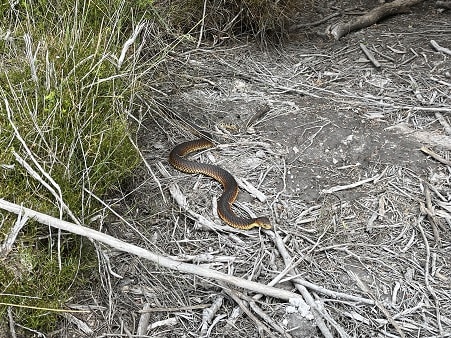
Bites are rare with lowland copperheads, and we don’t have dozens of detailed, multi day bite reports as with eastern brown snakes. What’s known is that Austrelaps superbus is just as neurotoxic as its Australian neighbours. An average bite produces 26mg of venom, with a maximum of 85mg, and if every drop of that successfully injects, you may experience drowsiness, clumsiness, laboured breathing and even fully fledged paralysis.
Dogs are also vulnerable, as shown by a faithful mutt which was bitten in 2017, and soon experienced neuromuscular paralysis and respiratory failure. The dog happily recovered after an injection of antivenom. Lowland copperhead venom is equal to the Indian cobra drop for drop, yet its personality is far less aggressive. They move around the countryside slowly, and will only attack if seriously provoked.
Australian copperheads lack a dedicated antivenom, and tiger snake serum is used by virtually all hospitals. Outside of the 3 member Austrelaps family, tiger snakes are their closest relative, and there’s sizeable toxin overlap. A 2003 study used chick and mouse muscle preparations, and tested 3 snake venoms: tiger snake, lowland copperhead, and Stephen’s banded snake. When 1 unit of tiger snake antivenom was applied beforehand, the neurotoxic effects of tiger snake and lowland copperhead were completely prevented. Stephen’s banded snake was only partly softened. When 5 units of antivenom were used, neurotoxicity was completely prevented for all 3 snakes.
| 3 | Lurks in overgrown grass |
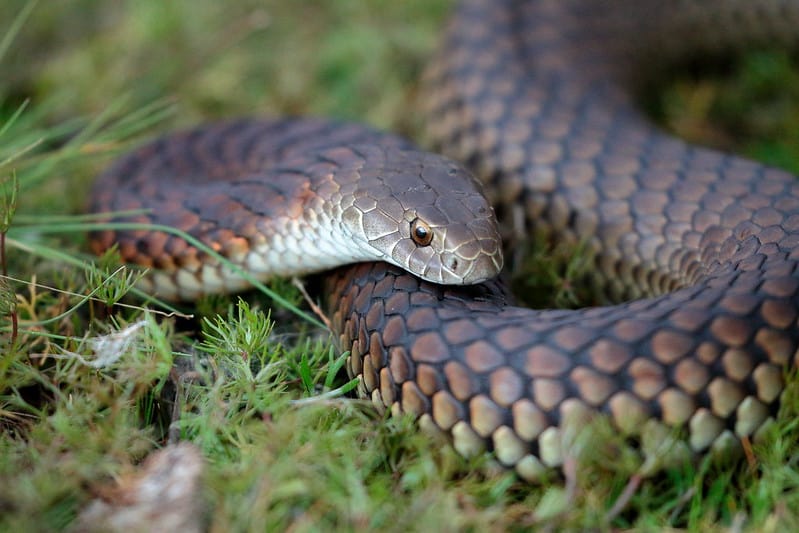
Lowland copperheads have killed just 1 person in Australian history, but rather than weakness, this is mainly down to their shy temperament. Their venom is undoubtedly strong enough to wipe you out. While the yield is low, the raw toxicity is high, at various estimates of 0.48mg, 0.50mg and 0.56mg in mice. Eastern brown snakes score 0.05mg, while red-bellied black snakes score 2.45mg.
Despite rarely killing, lowland copperheads are a fearsome opponent if they decide to turn on you. Unlike the eastern brown snake, which is constantly twitchy and nervous, lowland copperheads take confidence in their venom arsenal, and prefer to lurk calmly in long grasses or between bushes.
Aside from lunging forward for a bite, lowland copperheads have two classic defensive tricks. The first is flattening their neck and body, in an attempt to look larger. This deception may succeed against hungry black hawks; against humans is debatable. The second is thrashing their body from side side, probably to create an impression of unhinged aggression and propensity to violence. It’s rare for lowland copperheads to flee at high speeds. They also flatten their body while basking on rocks, to increase the surface area the sun’s rays can absorb into.
| 4 | Cold resistance |
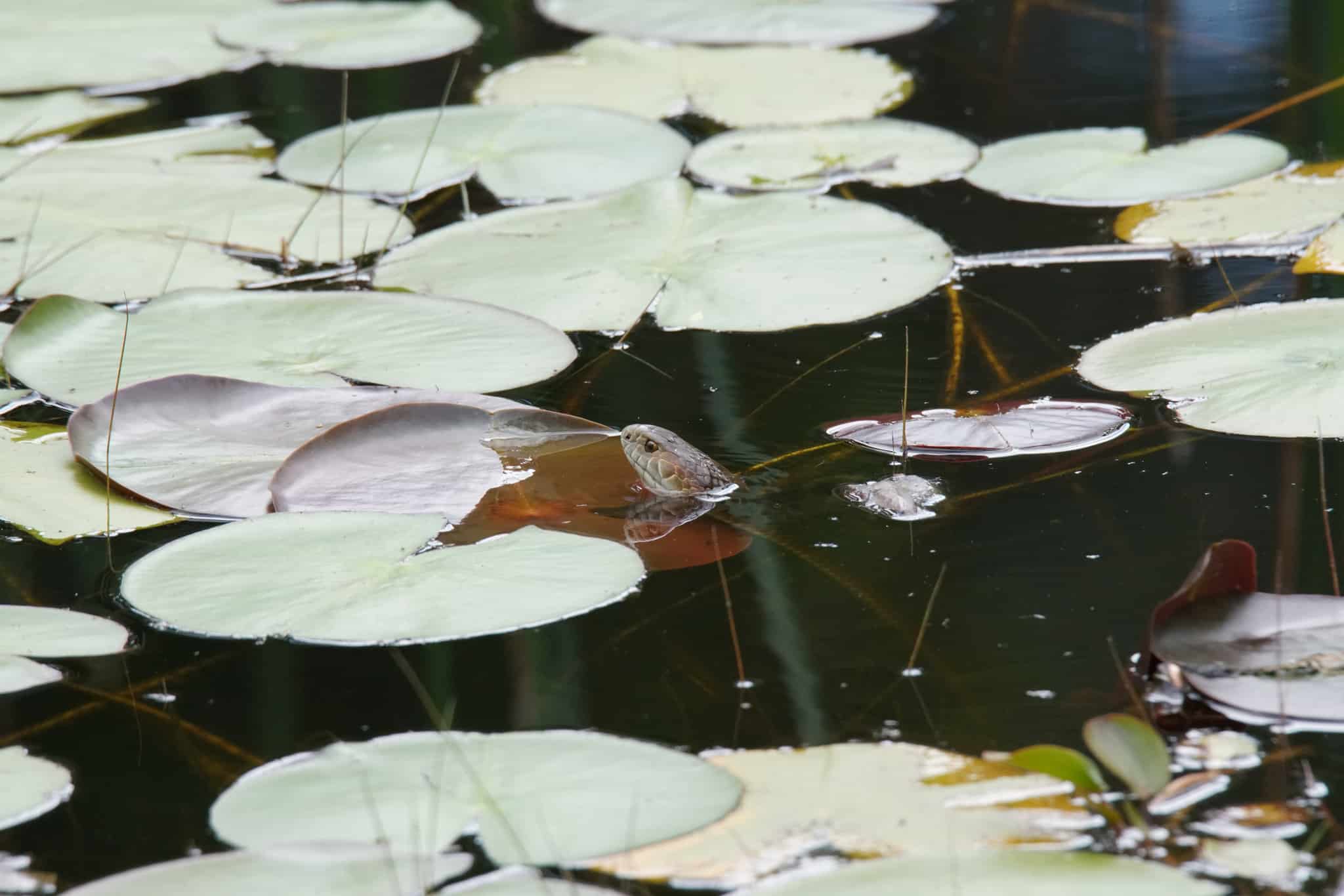
While causing few deaths, lowland copperheads defeat all over venomous Australian snakes in one respect: they have the highest tolerance for cold. They emerge from hibernation earlier than eastern browns or tiger snakes, and will prowl around eagerly on cool mornings where their venomous neighbours huddle in shelter. They also enter hibernation later, sometimes waiting until late May. Occasionally, Austrelaps superbus can be spotted basking in the cool sunlight in mid-winter. Something about their physiology allows them to withstand low temperatures, and they even appear above the snow line in New South Wales.
The reverse also applies: lowland copperheads only live in the southernmost regions of Australia, rather than the roasting north. They inhabit parts of New South Wales and South Australia, and most of the island of Tasmania. You won’t find lowland copperheads on the west coast, in Northern Territory, the outback, or even anywhere near Sydney.
Tasmania is far less of a snakepit than mainland Australia, with just three native species. The lowland copperhead is one, followed by the venomous tiger snake and harmless white-lipped snake.
| 5 | Often appears near tiger snakes |
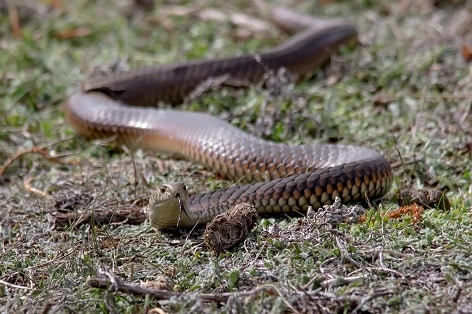
Lowland copperheads aren’t a territorial species. They have no issue with fellow species members sharing a streamside enclave, and at times, lowland copperheads can swell to large numbers in one spot. These gatherings are particularly likely in open grassy fields with a water source nearby, and scattered rocks.
Likewise, lowland copperheads are comfortable with “rival” snake species. They have a particularly close correlation with the tiger snake, and in Tasmania they can be seen foraging and basking mere metres from each other.
Copperheads lay 10-45 young, in the form of live young rather than eggs, with an average of 14.6. They’re relatively humble breeders and usually produce a clutch every 2 years. Population analysis reveals a skewed sex ratio, with males outnumbering females. In humans, the birth sex ratio is 1.07 males/females, decreasing with age, particularly over the age of 65, when it swings sharply in favour of females. Lowland copperheads are also a notoriously parasite infected snake. Ticks are constantly visible beneath its skin, and one individual contained over 60.
| 6 | Diet: prefers amphibians and reptiles |
One study decided to examine tiger snakes and lowland copperheads in the same location, to see how their lifestyles compared. The study took place in Tasmania over 2 years, using living snakes and dead ones found as roadkill.
In total, scientists identified 55 prey in lowland copperheads and 25 in tiger snakes. The two snakes had completely different diets. Tiger snakes ate a flexible diet, particularly favouring mammals, including the invasive house mouse and black rat. They also ate plenty of birds, particularly the superb farywen. Meanwhile, Australian copperheads mostly ate cold-blooded prey. 1 of 55 prey was a mammal, a house mouse (Mus musculas). Amphibians were most common, the most abundant species being spotted grass frogs and pobblebonk frogs. They also ate reptiles such as metallic skinks and Entrecasteaux’s skinks. The final total was 44 amphibians and 10 reptiles.
Hence, the two are able to coexist without constant wars and competition. Their differing diets were even noticeable in their body conditions. Tiger snakes were commonly adorned with gnawing bite marks and scars from rodent prey, but this was rare in lowland copperheads. 24% of tiger snakes had wounds versus 2% of copperheads.
| 7 | Assaults muscle tissue |
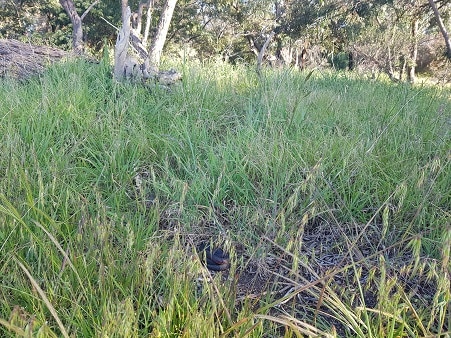
Lowland copperheads also have myotoxic properties, e.g. they possess toxins which target muscle fibres, as a wicked back up to their neurotoxic powers.
In 1998, scientists conducted an experiment using myoblasts, the precursor to muscle tissue. They tested 7 native Australian snake species. Venom of the mulga had the strongest myotoxic properties, but the lowland copperhead came second. Three snake venoms caused morphological changes in the myoblasts within 30 minutes: mulgas, lowland copperheads, and red-bellied black snakes. Another two were weaker, causing structural changes after 60 minutes: death adders and the tiger snake. Coastal taipans had weak myotoxic properties, achieving change after 2 hours. Peninsular brown snakes had virtually no effect.
Dark urine has been reported after lowland copperhead bite. This is a classic symptom of elevated myoglobin in the bloodstream, a consequence of muscle tissue destruction. Other effects include haemorrhaging due to phospholipase A2s, which block platelet aggregation and cause haemolysis of red blood cells. These PLA2s are a form found only in the Aussie copperhead family, and have the catchy name of superbins, named after the Latin name. There’s 4 superbins ranging from A to D, and superbin A has the strongest activity against platelet aggregation.
| 8 | Dangerously patient |
Lowland copperheads have relatively short fangs, at just 3mm. These can pierce skin and inject their deadly elixir, but a proper pair of trousers or even long socks might be a barrier against the lowland copperhead, whereas it would fail against a death adder. Lowland copperheads still have a lightning fast lunge which should never be underestimated, despite being a steady slitherer overall.
Lowland copperheads like to remain motionless when hunting prey. In fact, they can remain so motionless that lizards scamper over their body, not realising that they’re standing on their worst nightmare. The lowland copperhead suddenly shifts, and swallows them up.
Lowland copperheads can take shelter in grass tussocks or below the fallen branches of an eucalyptus tree. They often rest in an S-coil, taking special care to shelter their head, so that their blatant serpent eyes don’t alert prey. An exposed body is not ideal, but far less of a giveaway. Lowland copperheads are mainly a ground-dwelling snake, climbing trees occasionally to investigate scents.
| 9 | Male on male wrestling |
Competitive wrestling is another characteristic of the lowland copperhead. Two males will approach each other and engage in a ferocious duel, and as this happens in mating season, it’s assumed that they’re competing for females.
One example happened in 1978 in Victoria, 6km south of the town of Mortlake. The two male snakes measured 1.5 metres each, and fought in a clearing between tall grass tussocks. While they snapped at each other viciously, their was never any prolonged chewing. They raised their heads 20cm above ground at times. The copperheads were so absorbed in their duel that they allowed researchers to step within 3 metres. The snakes only fled when locals pelted them with stones.
Lowland copperheads wrestle with their lower bodies intertwined, but rarely for wrestling snakes, with their upper bodies separated, so that they snap at each other from long distances. Apparently the Madagascar boa is one of the few other snakes to wrestle in this style.
| 10 | Subtle ID signs |
Lowland copperheads are never a stunningly colourful snake, but up close, their patterns gain new details which blend together from afar. The base colour is typically dark grey, but many lowland copperheads have a noticeable red tinges to their scales. This easily separates them from eastern brown snakes. You can also recognise Austrelaps superbus by a pale belly, which contrasts against their dark body. In some individuals, these pale scales spread to their back in sporadic patterns, never in neat zigzags or blotches, but an occasional patch here and there.
As a day-faring species, lowland copperheads have round black pupils, rather than viciously vertical like a viper. Their irises have a medium brown colour. Their head widens slightly from the neck, neither sharply triangular like a viper nor an indistinguishable tube.
Lowland copperheads can overwinter in a variety of locations, including below rocks, large logs and disused burrows. They’ve even been found inside hay bales, roofing iron and old tractor tires. Farmland might seem safer than the barren outback, but always be careful where you stick your arm.
